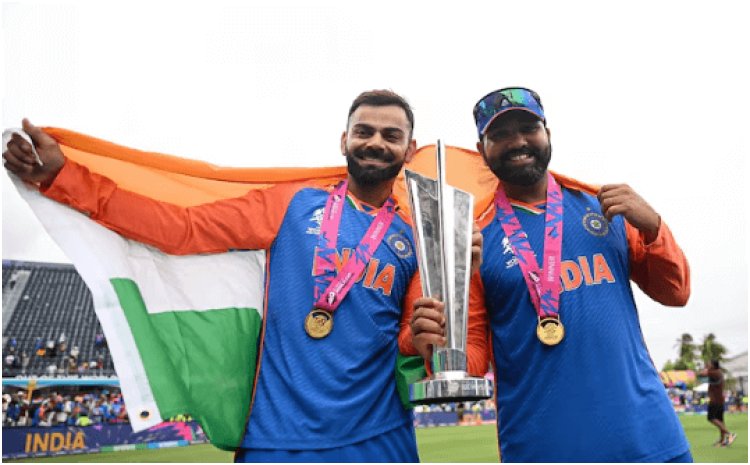India vs South Africa, T20 World Cup 2024 Final: India Triumphs by Mastering the T20 Code
India vs South Africa, T20 World Cup 2024 Final: India Triumphs by Mastering the T20 Code

India has finally cracked the T20 code, a milestone that marks a significant achievement in the country’s cricketing history.
For years, India has been a powerhouse in cricket, dominating in Test matches and One-Day Internationals (ODIs), but T20 success had often eluded them. This breakthrough signals not only a shift in strategy and mindset but also a testament to the depth and talent in Indian cricket.
The journey to mastering T20 cricket has been long and arduous. India’s initial approach to T20 was met with mixed results. Despite winning the inaugural T20 World Cup in 2007 under the leadership of MS Dhoni, the subsequent years saw inconsistent performances in major T20 tournaments. The Indian Premier League (IPL), launched in 2008, provided a platform for players to hone their skills, but translating IPL success to the international stage remained a challenge.
The turning point came with a strategic overhaul that focused on building a team specifically for T20 cricket. The selection committee, along with the team management, placed greater emphasis on versatility, fitness, and aggressive gameplay. The aim was to create a balanced squad capable of adapting to various match situations and conditions. Key players were identified not just for their batting or bowling prowess but also for their fielding abilities and cricketing acumen.
One of the most significant changes was the infusion of young talent into the team. The likes of Rishabh Pant, Shubman Gill, and Ishan Kishan brought fresh energy and fearless cricket to the squad. Their ability to play innovative shots and maintain a high strike rate added a new dimension to the team’s batting lineup. Simultaneously, experienced players like Virat Kohli, Rohit Sharma, and Jasprit Bumrah provided the stability and leadership needed to guide the younger players.
The role of the IPL cannot be understated in India’s T20 success. The league has been a breeding ground for new talent and has exposed Indian players to the best in the world. Competing alongside and against international stars has helped Indian players refine their skills and develop a better understanding of T20 cricket. The pressure-packed environment of the IPL has also prepared them mentally to handle high-stakes situations in international matches.
Another critical factor has been the evolution of India’s bowling attack. In the past, India often struggled to find bowlers who could perform consistently in T20 cricket. However, the emergence of bowlers like Bumrah, Yuzvendra Chahal, and Washington Sundar has transformed India’s bowling unit. These bowlers have the ability to take wickets at crucial moments and contain the opposition’s scoring rate, which is vital in T20 matches. The team management’s focus on nurturing young fast bowlers has also paid off, with the likes of Navdeep Saini and Deepak Chahar making significant contributions.
Fielding, often an overlooked aspect of cricket, has also seen tremendous improvement. India’s emphasis on fitness and athleticism has resulted in a team that excels in the field, saving crucial runs and taking stunning catches. The importance of fielding in T20 cannot be overstated, as the difference of a few runs can change the outcome of a match.
India’s strategic acumen has also played a crucial role in their T20 success. The coaching staff, led by head coach Rahul Dravid, has been instrumental in planning and execution. The team’s preparation is meticulous, with detailed analysis of opposition strengths and weaknesses, and tailored game plans for different conditions. The use of data analytics has become an integral part of the team’s strategy, helping in decision-making both on and off the field.
The captaincy of Virat Kohli and later Rohit Sharma has also been pivotal. Their leadership styles, though different, have complemented the team’s approach. Kohli’s aggressive and passionate demeanor inspired the team to play fearless cricket, while Sharma’s calm and composed nature provided the stability and clarity needed in high-pressure situations. Both leaders have been adept at making tactical decisions and motivating their players.
The breakthrough in T20 cricket has not only brought accolades but also united the cricket-crazy nation. Fans have celebrated the team’s success with immense pride and joy, and the players have become national heroes. This achievement has also inspired the next generation of cricketers, who now see T20 success as an attainable goal.
India’s mastery of T20 cricket is a result of meticulous planning, strategic changes, and the relentless pursuit of excellence. The combination of young talent, experienced leadership, and innovative strategies has created a formidable T20 team. This success story is a testament to the depth of talent in Indian cricket and the effectiveness of the systems in place. As India continues to dominate the T20 format, it sets a benchmark for other nations and cements its place as a cricketing powerhouse. The journey to cracking the T20 code has been challenging, but the rewards are evident, and the future of Indian T20 cricket looks brighter than ever.

 shivani
shivani 



